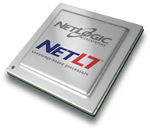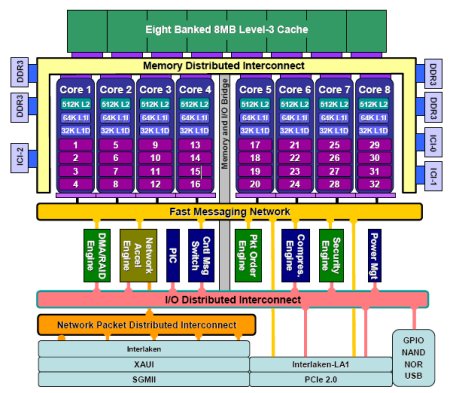MIPS64-based module supports 40Gbps network processing
Jul 8, 2010 — by Eric Brown — from the LinuxDevices Archive — 7 viewsNetLogic Microsystems announced a Linux-based hardware/software development kit it says is the first fully deterministic networking solution that concurrently processes Layers 2-7 at 40Gbps wire-speed. The NLX321103A solution combines the MIPS-based XLP832 eight-core, 32-threaded system-on-chip with the NL11k and NETL7 Layer 7 “knowledge-based” processors, the company says.
 The NLX321103A solution represents the first major integration of NetLogic Microsystems' networking processors, such as its NETL7 processor (pictured at right), with the MIPS-based system-on-chips (SoCs) the company acquired when it purchased RMI (formerly Raza Microelectronics, Inc.) last October. The NLX321103A solution is said to enable simultaneous, deterministic processing of advanced networking functions ranging from packet inspection to cryptography to quality of service (QoS).
The NLX321103A solution represents the first major integration of NetLogic Microsystems' networking processors, such as its NETL7 processor (pictured at right), with the MIPS-based system-on-chips (SoCs) the company acquired when it purchased RMI (formerly Raza Microelectronics, Inc.) last October. The NLX321103A solution is said to enable simultaneous, deterministic processing of advanced networking functions ranging from packet inspection to cryptography to quality of service (QoS).
Typically, manufacturers deploy Layer 2-4 and Layer 4-7 processing on separate cards and selectively perform certain functions only on a fraction of network traffic, thereby compromising integrity, says NetLogic. In contrast, the NLX321103A supports Layers 2-7 on a single card at 40Gbps wire-speed, processing every packet with minimal network latency, claims the company.
NetLogic did not describe the exact dimensions of the NLX321103A, nor it did mention any I/O details. The device would appear to be a processor module, but may also take the form of a carrier board.
The solution is said to combine the following components:
- XLP832 eight-core, 32-threaded MIPS64 SoC with 40 plus autonomous programmable processing engines
- 128 NL11k knowledge-based processing engines
- 196 NETL7 Intelligent Fabric for Automata (IFA) engines
The XLP832 SoC
RMI announced the XLP832 SoC in May 2009 shortly before NetLogic Microsystems announced plans to acquire the company. The SoC was billed as being the first superscalar, 40nm-fabricated member in a family of multi-core MIPS64-based SoCs, and the first to support both data- and control-plane processing.
The XLP832 mixes eight "EC4400" MIPS64 cores, each with four threads, or "NXCPUs," and can be clocked from 500MHz to over 2GHz. The XLP732 is claimed to offer three times the performance per Watt of the previous 1.5GHz XLR family.
The XLP's EC4400 cores are touted for offering fine-grained multi-threading capability targeting throughput-oriented data plane processing tasks. Its superscalar engine offers out-of-order execution capabilities that are said to facilitate high-performance control plane processing, says the company.

XLP832 block diagram
(Click to enlarge)
By combining quad-issue instruction scheduling and simultaneous four-way multi-threading within each core, the XLP is claimed to support high-performance data plane and control plane operation within a single chip. The 32 NXCPUs within the XLP832 are equipped with a tri-level cache architecture with over 12.5MB of "fully coherent" on-chip cache, enabling the SoC to deliver 40 Terabits per second (Tbps) of on-chip memory bandwidth, claims NetLogic
The XLP processor also includes over 40 autonomous, programmable processing engines for independently offloading network functions, says NetLogic. These are said to include IPSec/SSL security encryption/decryption/authentication, packet parsing, packet queuing, packet management, compression/decompression, packet ordering, storage de-duplication, RAID5/RAID6, TCP segmentation, and IEEE1588 hardware time stamping.
The NL11K processor
The XLP832 processor interfaces directly over a 50Gbps, low-latency serial bus to an undefined number of NL11k "knowledge-based" processors, providing high-speed access to 128 processing engines for Layers 2-4 flow classification, IPv4/IPv6 forwarding, ACL security, and QoS policing, says NetLogic.
The company offered few details about the 40nm-fabricated NL11k, which appears to be a new, serial-savvy spin-off from the NETL7 line of networking chips. The NL11K integrates a high-speed serial interface to deliver up to 225Gbps of raw, chip-to-chip interconnect bandwidth, says NetLogic. The NL11K is also claimed to be able to process up to a billion "decisions" per second.
The NETL7 engines
The XLP832 SoC interfaces over a second set of high-speed serial busses, providing a direct connection to one or more of the Layer 7-focused NETL7 processors. As Netlogic describes, it the entire NLX321103A solution offers "196 of NetLogic's third-generation Intelligent Fabric for Automata (IFA) engines from the NETL7 Layer 7 family."
The NETL7-based IFA engines are optimized to inspect millions of network flows against hundreds of thousands of complex Perl Compatible Regular Expression (PCRE) signatures, claims the company. The IFA engines are also said to natively perform stateful cross-packet inspection in hardware.
Integrating their own on-chip memory, the IFA engines provide over 500Tbps of low latency access bandwidth to on-chip signature databases for accelerating content inspection, claims NetLogic. The IFA engines are also said to provide support for over 76.6Tbps of state transition bandwidth.
The NLX321103A solution requires no external glue-logic for connection among the processors, says the company. A Linux-based software development kit (SDK) is said to be available along with the NLX321103A module. This appears to be based on the XLP's SDK, which uses Linux 2.6.21 (see the link below for more details).
Stated Mike Coward, CTO at Continuous Computing, "We are excited to be offering our latest generation ATCA products using NetLogic Microsystems' multi-core, multi-threaded processors and knowledge-based processors."
Availability
The NLX321103A solution is expected to sample in the third quarter. No further information on the solution is currently available, but there is more background on its components, including the XLP family here, the NETL7 family, here, and the Linux SDK for the XLP, here.
This article was originally published on LinuxDevices.com and has been donated to the open source community by QuinStreet Inc. Please visit LinuxToday.com for up-to-date news and articles about Linux and open source.